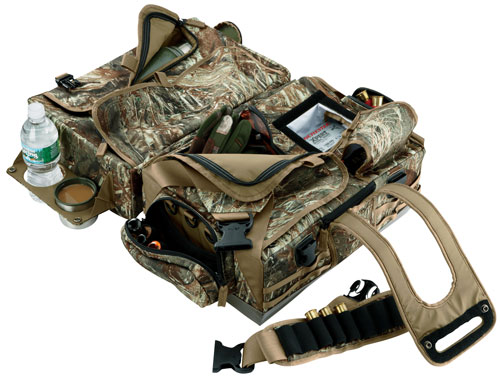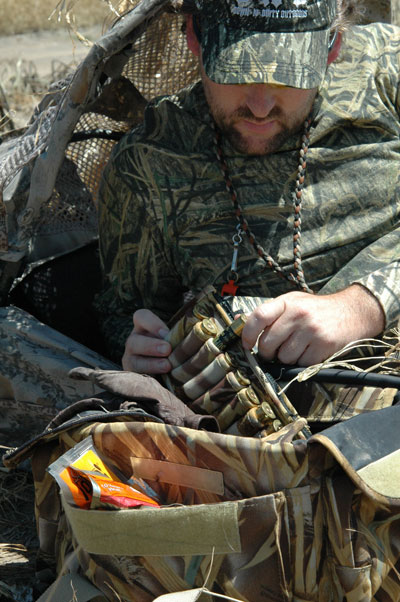 A well-stocked blind bag is the epicenter of a waterfowler’s world, serving as a survival kit for a long season in the field. For some hunters, an oversized bag holds more shells than they could ever shoot, along with every worst-case scenario non-necessity they can think of, while minimalists carry just enough to fit in a few coat pockets and then beg whatever else they need off of friends.
A well-stocked blind bag is the epicenter of a waterfowler’s world, serving as a survival kit for a long season in the field. For some hunters, an oversized bag holds more shells than they could ever shoot, along with every worst-case scenario non-necessity they can think of, while minimalists carry just enough to fit in a few coat pockets and then beg whatever else they need off of friends.
The start of a savvy hunter’s kit requires the right-sized bag: one that’s not too big and not too small. Most hunters err on the side of elephantine and then stuff the thing so full it requires nothing short of a sherpa to pack it to the pit. By downsizing, you won’t be tempted to carry things you probably won’t need and will save your back in the process.
A Goldilocks’ bag — the one that’s just right — should offer an ample, but not oversized, main compartment, along with an array of exterior pockets. Recently introduced innovations have been trending to expandable, adjustable interiors to help organize gear, as well as specialized bags, such as the Final Approach Layout Blind Bag, that cater to a particular style of hunting. All things to think about when shopping.
When you have your bag in hand, it’s time to make a list of what you’re going to fill it with. As you write down each item, think long and hard about whether it’s a need-to-have or nice-to-have and make a corresponding mark next to it. A headlamp is probably a necessity if you’re going to be setting dekes in the dark. Extra decoy weights probably aren’t. And that second box of Triple Bs? Definitely not.
In fact, let’s talk about those extra shells for a second, because that’s what makes up most of the weight you’ll be humping into the field. In most areas, waterfowl limits equal five or six ducks and maybe a couple of geese. If reaching that limit requires more than one, or even two, boxes of shells, you might want to think about taking up another sport. At most, you should pack a box of duck shells and a box, or less, of goose loads. Anything more is overkill (unless, of course, you’re hunting snow geese in the spring).
 Other items that might go in your bag, depending on how and when you hunt, include gloves, gaiters and wool cap; chemical handwarmers; call lanyard; multi-tool; collapsible cleaning rod; camera and licenses. Leave room for a breakfast bar or two and a small thermos, and you should be well equipped for a day in the field, which is what a typical duck hunt entails. So why pack like you’re going on an expedition?
Other items that might go in your bag, depending on how and when you hunt, include gloves, gaiters and wool cap; chemical handwarmers; call lanyard; multi-tool; collapsible cleaning rod; camera and licenses. Leave room for a breakfast bar or two and a small thermos, and you should be well equipped for a day in the field, which is what a typical duck hunt entails. So why pack like you’re going on an expedition?
You’ve made your list and checked it twice, now organize the bag so there’s a designated place for everything and put everything in its place. Goose shells and calls can go in an exterior pocket, where you can get to them quickly should the opportunity present itself. You’ll most likely need your headlamp or flashlight first thing in the morning, so put it somewhere easily accessible, like a front pocket or rear pouch. In the main compartment goes a box of duck loads and calls, camera with Gorillapod, spinning-wing-decoy battery and breakfast. Put a spare pair of gloves and extra cap in an exterior pocket or near the bottom of the bag where they can stay all season or until you need them.
As the season progresses, take inventory of your bag’s contents and weed out unnecessary items. By mid-October, that bug spray is probably not needed. Replace it with handwarmers or an extra gaiter. Consolidate half-boxes of shells, and swap the teal loads for something more appropriate for fat, late-season mallards. Throw away any trash, such as candy-bar wrappers and empty hulls. Stay on top of things so you’re not digging through the detritus of duck season when it’s time to reload.
All of this might seem a bit on the obsessive-compulsive side, but having a plan for packing your blind bag and sticking to it will not only save your sanity, but can save money as well. By keeping a running inventory, you’ll spend less on extra shells, spare gloves and gear to replace what you thought was lost but was really buried in the bottom of your bag.






